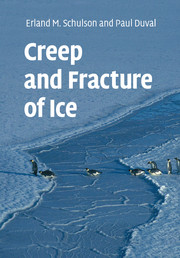Book contents
- Frontmatter
- Contents
- Preface
- Acknowledgements
- 1 Introduction
- 2 Structure of ice
- 3 Microstructure of natural ice features
- 4 Physical properties: elasticity, friction and diffusivity
- 5 Plastic deformation of the ice single crystal
- 6 Ductile behavior of polycrystalline ice: experimental data and physical processes
- 7 Modeling the ductile behavior of isotropic and anisotropic polycrystalline ice
- 8 Rheology of high-pressure and planetary ices
- 9 Fracture toughness of ice
- 10 Brittle failure of ice under tension
- 11 Brittle compressive failure of unconfined ice
- 12 Brittle compressive failure of confined ice
- 13 Ductile-to-brittle transition under compression
- 14 Indentation fracture and ice forces on structures
- 15 Fracture of the ice cover on the Arctic Ocean
- Index
- References
9 - Fracture toughness of ice
Published online by Cambridge University Press: 01 February 2010
- Frontmatter
- Contents
- Preface
- Acknowledgements
- 1 Introduction
- 2 Structure of ice
- 3 Microstructure of natural ice features
- 4 Physical properties: elasticity, friction and diffusivity
- 5 Plastic deformation of the ice single crystal
- 6 Ductile behavior of polycrystalline ice: experimental data and physical processes
- 7 Modeling the ductile behavior of isotropic and anisotropic polycrystalline ice
- 8 Rheology of high-pressure and planetary ices
- 9 Fracture toughness of ice
- 10 Brittle failure of ice under tension
- 11 Brittle compressive failure of unconfined ice
- 12 Brittle compressive failure of confined ice
- 13 Ductile-to-brittle transition under compression
- 14 Indentation fracture and ice forces on structures
- 15 Fracture of the ice cover on the Arctic Ocean
- Index
- References
Summary
Introduction
We turn now from lower-rate to higher-rate deformation and thus from creep to fracture. Accordingly, we focus on cracks. They are ubiquitous within natural features, such as the ice cover on the Arctic Ocean (http://psc.apl.washington.edu/Harry/Radarsat/images.html) and the icy crust of Europa (http://solarsystem.nasa.gov/galileo/gallery/europa.cfm), and play a major role in evolution of the bodies. Our interest is in their behavior, particularly in their resistance to propagation. This is expressed in terms of fracture toughness, a property that is fundamental not only to the scenes noted above but also to the calving of icebergs (Nye, 1957; Vaughan and Doake, 1996), to ice forces on engineered structures (Chapter 14) and to the ductile-to-brittle transition (Chapter 13). Fracture toughness is fundamental also to tensile (Chapter 9) and compressive (Chapters 11, 12) failure.
Our objectives in this chapter are to review briefly the principles underlying fracture mechanics, and then to discuss methods of measuring the fracture toughness of ice and factors that affect the property. For comparison, we include a short discussion of lightly consolidated snow.
Principles of fracture mechanics
The energy dissipated during fast crack propagation through ice is governed to a large degree by the energy required to create new surface. Hence, we base our discussion upon the theory of linear-elastic-fracture mechanics (LEFM). More complete treatments of fracture mechanics may be found in books by Knott (1973), Broek (1982), Atkinson (1989), Lawn (1995) and Anderson (1995).
- Type
- Chapter
- Information
- Creep and Fracture of Ice , pp. 190 - 211Publisher: Cambridge University PressPrint publication year: 2009
References
- 1
- Cited by



